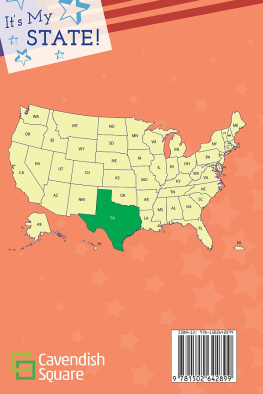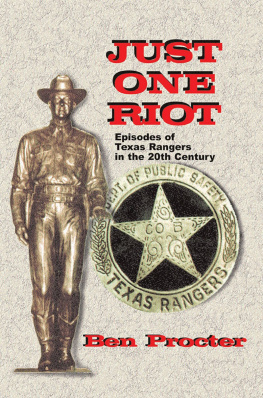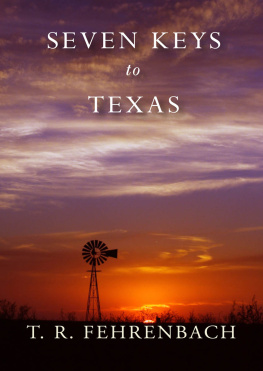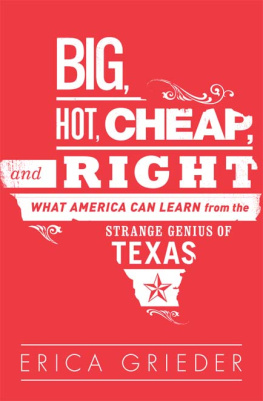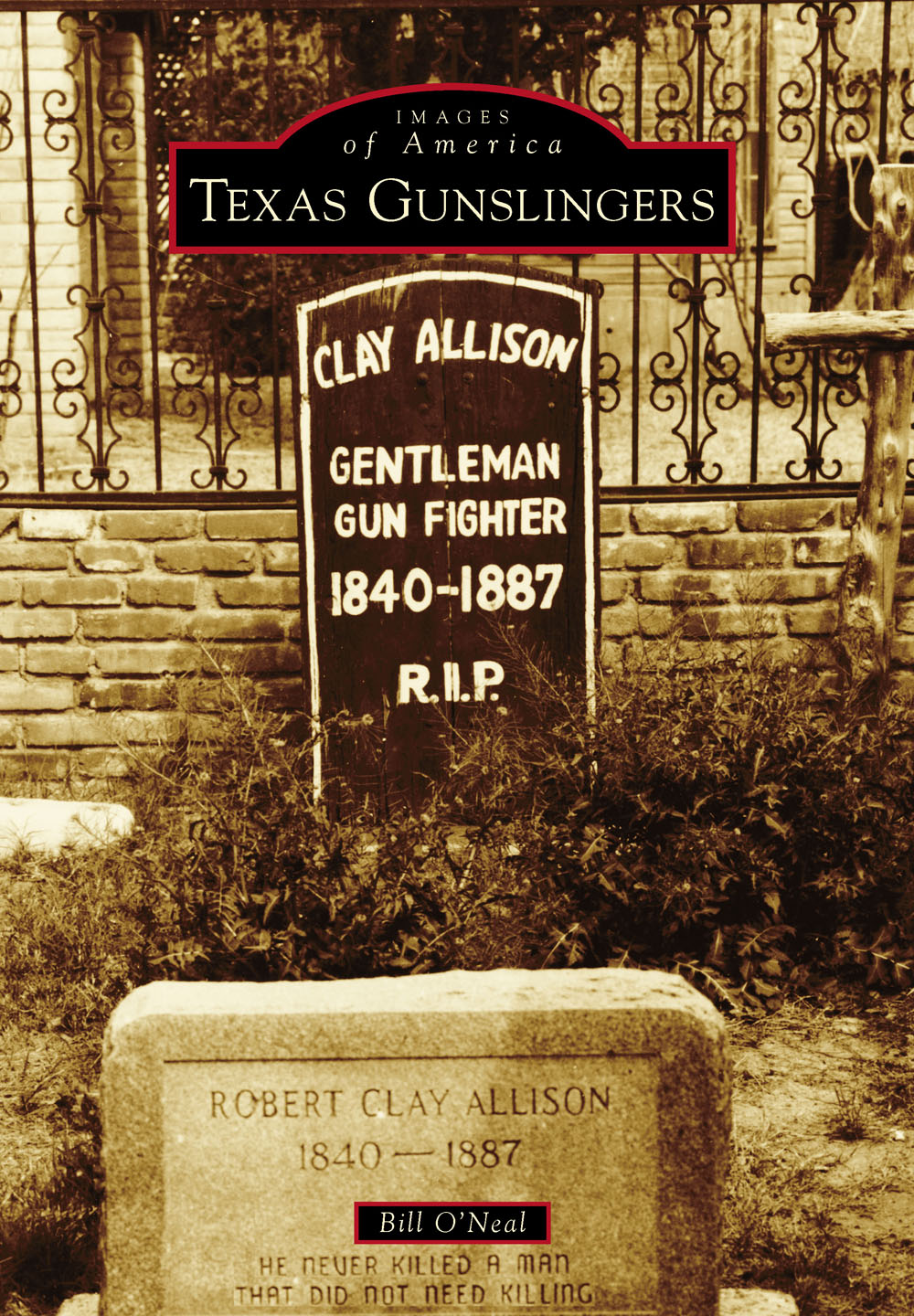
IMAGES
of America
TEXAS GUNSLINGERS
ON THE COVER: In 1866, Clay Allison, a Civil War veteran from Tennessee, moved to Texas. He worked as a drover for legendary cattleman Charles Goodnight before establishing a ranch in New Mexico. Allison engaged in gunplay in New Mexico and Colorado, killing four adversaries. He died accidentally after buying supplies in Pecos, where he is buried. Indeed, more gunslingers diedand were buriedin Texas than in any other state or territory. (Photograph by the author.)
IMAGES
of America
TEXAS GUNSLINGERS
Bill ONeal

Copyright 2014 by Bill ONeal
ISBN 978-1-4671-3271-8
Ebook ISBN 9781439648926
Published by Arcadia Publishing
Charleston, South Carolina
Library of Congress Control Number: 2014943074
For all general information, please contact Arcadia Publishing:
Telephone 843-853-2070
Fax 843-853-0044
E-mail
For customer service and orders:
Toll-Free 1-888-313-2665
Visit us on the Internet at www.arcadiapublishing.com
For my sons-in-law: Rudy Martinez, Drew Gormley, and Dusty Henderson
CONTENTS
ACKNOWLEDGMENTS
This book was proposed to me by Jared Nelson of Arcadia Publishing, and I was delighted at the opportunity to apply the Arcadia treatment to a subject that I have researched and written about for more than 40 years. My editors for this project were Blake Wright and Jeff Ruetsche, who were unfailingly helpful and gracious. The Arcadia production team applied their customary expertise to faded images from the 19th century. Texas Gunslingers is my fifth title for Arcadia, and I continue to be impressed by the high quality of professionalism and creativity with which the staff embraces each new book.
Sherri Baker, interlibrary loan specialist at Panola College in Carthage, located obscure books and images for me with her usual zeal for detective work. My first book, Encyclopedia of Western Gunfighters, remains in print after 35 years and has been published in several foreign editions. I have written biographies about gunfighters and accounts of feuds and range wars. In putting together these books, I have accumulated a large collection of images, as well as boxes and file cabinets full of gunfighter research. Therefore, when Arcadia Publishing invited me to write about Texas gunfighters, I already had most of what I needed at my home office, and my various acknowledgements of debts have been listed and detailed in earlier books.
But Chuck Parsons, a noted researcher and writer in the field of Texas Rangers and outlaws, granted permission for me to use certain images for this project. My daughter, Dr. Berri Gormley, took needed photographs on short notice at the Texas Ranger Hall of Fame and Museum. On an impromptu trip to Timpson to find and photograph a gravestone, my wife, Karon, and I were given invaluable help by staff members at city hall. And Karon, as always, cheerfully provided a sounding board throughout this project, then prepared the manuscript for the publishers. I could not complete a book without her.
INTRODUCTION
The gunfighter is a compelling figure of the Western frontier. Nothing is more dramatic than life-and-death conflict, and the image of men in big hats and boots brandishing six-shooters and Winchesters has been portrayed in countless novels, movies, and television shows. Nowhere is the gunfighter image more deeply emblazoned than in Texas. Indeed, Texas may be considered the Gunfighter Capital of the West. After the cowboya Texas creationthe most colorful and romanticized frontier figure is the gunfighter.
Texas made an enormous contribution to gunfighter lore. The revolving pistol, key weapon of gunfighters, evolved in Texas. Early Texas Rangers, desperate for a repeating weapon that could be used from horseback against mounted Comanche warriors, adapted Samuel Colts little five-shooter revolvers. Soon, Texas Rangers secured improvements for Colts pistols, which became larger, more powerful six-guns. Armed with at least two of these six-shooters, mounted Rangers could fire 12 rounds without reloading. In Texas, the US Army learned from Ranger tactics how to combat horseback warriors. In the 1850s, a US Cavalry regiment was organized and stationed in Texas, and each trooper carried a cap-and-ball six-shooter. Soon, these tactics and weapons would be utilized by cavalry units against horseback warriors all over the West.
During the 1850s, these same six-shooters began to be used by Texans against each other. Ben Thompson of Austin became the first gunfighter of note, and many more Texas men began to blaze away at each other with deadly intent and increasing skill. Most Western states and territories saw widespread gunplay for only a brief number of years before law and order prevailed: Kansas, for example, during the cattle-town era; New Mexico during the murderous Lincoln County War; and Oklahoma during its lawless heyday as an outlaw refuge. But in Texas, gunslingers first unlimbered six-shooters against each other during the 1850s and continued to blaze away until past the turn of the century.
A survey of 256 Western gunfighters and 589 shootouts in which they participated (Encyclopedia of Western Gunfighters, University of Oklahoma Press, 1979) reveals that Texans dominated the tally sheet of frontier pistoleers. More of these gunfightsnearly 160occurred in Texas than in any other state or territory. No other Western state or territory was the arena of even half as many shootings. In rating gunfighters according to the number of killings each, as well as the total shootouts participated in, 10 of the deadliest 15 spent most of their careers in Texas. The top 15, with those from Texas italicized, were Jim Miller, John Wesley Hardin, Harvey Logan, Wild Bill Hickok, John Selman, Dallas Stoudenmire, King Fisher, Billy the Kid, Ben Thompson, Henry Brown, John Slaughter, Cullen Baker, Clay Allison, Jim Courtright, and John Hughes. More gunfighters were born in Texas than in any other state or territory, and more died in Texas.
There were more blood feuds in Texas than in any other state. The Regulator-Moderator War of the 1840s introduced feuding to Texas, and for the next three-quarters of a century, there were vicious outbreaks of violence between families or factions. These feuds featured ambushes, street fights, lynchings, night riders, hired killers, and unforgiving vendettas. Dr. C.L. Sonnichsen, the first student of Texas feuds (Ill Die Before Ill Run and Ten Texas Feuds) made the observation: Vengeance is mine! saith the Lord. But in and out of Texas he has always had plenty of help.
Killin Jim Miller was the Wests premier assassin, more lethal than even the legendary Tom Horn. For a time, Miller specialized in killing Mexican sheepherders during the range troubles in Texas between cattlemen and sheep ranchers. Mannen Clements, an in-law of Miller, expressed the same professional outlook: For three hundred dollars Id cut anybody in two with a sawed-off shotgun.
Shortly before being hanged for murder in 1878, 27-year-old Bill Longley reflected: My first step was disobedience; next whiskey drinking; next carrying pistols; next gambling, and then murder, and I suppose next will be the gallows. Dallas Stoudenmire, who repeatedly displayed ferocious courage during Civil War combat and in eight gunfights, confidently proclaimed: I dont believe the bullet was ever molded that will kill me. But he was proved wrong during an 1882 saloon brawl in El Paso.
Next page

